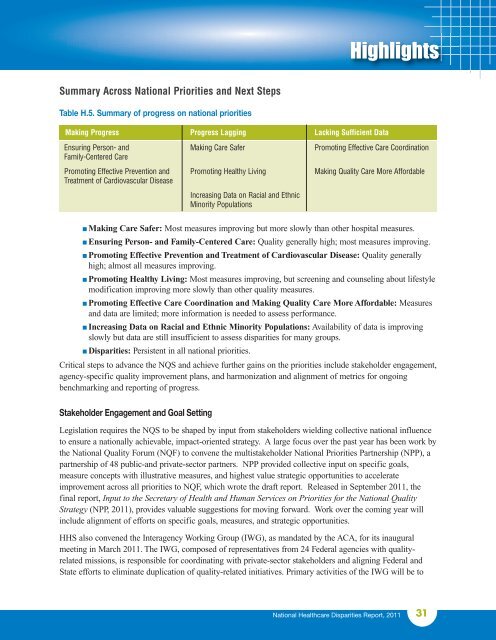National Healthcare Disparities Report - LDI Health Economist
National Healthcare Disparities Report - LDI Health Economist
National Healthcare Disparities Report - LDI Health Economist
You also want an ePaper? Increase the reach of your titles
YUMPU automatically turns print PDFs into web optimized ePapers that Google loves.
Highlights<br />
Summary Across <strong>National</strong> Priorities and Next Steps<br />
Table H.5. Summary of progress on national priorities<br />
Making Progress Progress Lagging Lacking Sufficient Data<br />
Ensuring Person- and Making Care Safer Promoting Effective Care Coordination<br />
Family-Centered Care<br />
Promoting Effective Prevention and Promoting <strong>Health</strong>y Living Making Quality Care More Affordable<br />
Treatment of Cardiovascular Disease<br />
Increasing Data on Racial and Ethnic<br />
Minority Populations<br />
n Making Care Safer: Most measures improving but more slowly than other hospital measures.<br />
n Ensuring Person- and Family-Centered Care: Quality generally high; most measures improving.<br />
n Promoting Effective Prevention and Treatment of Cardiovascular Disease: Quality generally<br />
high; almost all measures improving.<br />
n Promoting <strong>Health</strong>y Living: Most measures improving, but screening and counseling about lifestyle<br />
modification improving more slowly than other quality measures.<br />
n Promoting Effective Care Coordination and Making Quality Care More Affordable: Measures<br />
and data are limited; more information is needed to assess performance.<br />
n Increasing Data on Racial and Ethnic Minority Populations: Availability of data is improving<br />
slowly but data are still insufficient to assess disparities for many groups.<br />
n <strong>Disparities</strong>: Persistent in all national priorities.<br />
Critical steps to advance the NQS and achieve further gains on the priorities include stakeholder engagement,<br />
agency-specific quality improvement plans, and harmonization and alignment of metrics for ongoing<br />
benchmarking and reporting of progress.<br />
Stakeholder Engagement and Goal Setting<br />
Legislation requires the NQS to be shaped by input from stakeholders wielding collective national influence<br />
to ensure a nationally achievable, impact-oriented strategy. A large focus over the past year has been work by<br />
the <strong>National</strong> Quality Forum (NQF) to convene the multistakeholder <strong>National</strong> Priorities Partnership (NPP), a<br />
partnership of 48 public-and private-sector partners. NPP provided collective input on specific goals,<br />
measure concepts with illustrative measures, and highest value strategic opportunities to accelerate<br />
improvement across all priorities to NQF, which wrote the draft report. Released in September 2011, the<br />
final report, Input to the Secretary of <strong>Health</strong> and Human Services on Priorities for the <strong>National</strong> Quality<br />
Strategy (NPP, 2011), provides valuable suggestions for moving forward. Work over the coming year will<br />
include alignment of efforts on specific goals, measures, and strategic opportunities.<br />
HHS also convened the Interagency Working Group (IWG), as mandated by the ACA, for its inaugural<br />
meeting in March 2011. The IWG, composed of representatives from 24 Federal agencies with qualityrelated<br />
missions, is responsible for coordinating with private-sector stakeholders and aligning Federal and<br />
State efforts to eliminate duplication of quality-related initiatives. Primary activities of the IWG will be to<br />
<strong>National</strong> <strong><strong>Health</strong>care</strong> <strong>Disparities</strong> <strong>Report</strong>, 2011<br />
31

















